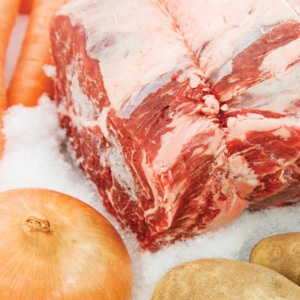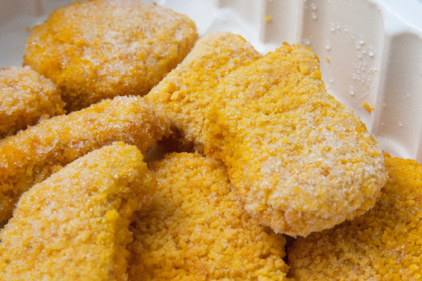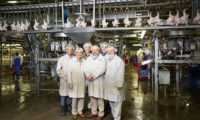In general, most meat and poultry products have relatively high-water contents and a corresponding higher amount of thermal energy to be removed during freezing. In most cases, high-velocity air blast systems are used for these protein products, and systems that expose as much of the product surface to as much low-temperature air as possible are preferred.

|
Freezing for most food products is a quality issue, says Dennis R. Heldman of Heldman Associates, Mason, Ohio.
“In general, slow freezing creates large ice crystals within the product structure,” he explains. “If the product structure is muscle or cellular, the large ice crystal may cause rupture of the structure, and lead to texture changes and/or chemical reactions with negative impact on the aroma or flavor of the product. Rapid freezing results in small ice crystals within the product structure, and is the preferred approach.”
Unfortunately, rapid freezing is more costly and cannot be accomplished uniformly in products with larger mass and dimensions.
“The selection of the most appropriate freezing system is a trade-off between achievement of the desired quality and the cost of operating the system,” Heldman says.
Freezing costs
Although freezing of foods is viewed as an energy-intensive process, four key process and product characteristics impact the energy requirements of the process, he says. The first is the size of product piece being frozen. This factor dictates the distance thermal energy must transfer to be removed from the product, Heldman explains.
This situation exists in many meat and poultry products where larger sizes increase the amount of thermal energy needed to be removed from the products. Temperature difference between product and the refrigerant, or cold air, also is a factor.
“While lower temperature of air increases the temperature difference and increases the rate of thermal energy removal, creating lower temperature air increases the operating cost of refrigeration system,” Heldman explains. Another factor is the transfer of thermal energy at the product surface.
“This transfer is enhanced by high air velocity over the product surface — air blast — but operating costs increase as air velocity is increased,” Heldman says. “This factor is also impacted by the packaging used, since the package or container introduces an additional barrier to thermal energy transfer.”
Finally, product composition impacts energy costs as well. Heldman explains that products with high-water content require removal of higher amounts of thermal energy, due to larger amounts of latent heat, the change of phase of liquid to solid or ice.
“In addition, composition influences the product properties with direct impact on rate of thermal energy transfer,” Heldman explains. A portion of the energy cost associated with frozen foods also is the low temperature required during storage, distribution and delivery to the consumer, he adds.
“The key change that has occurred in the recent past is an overall reduction in the storage time between product freezing and delivery to the consumer,” Heldman says. “This step impacts the amount of frozen food held in inventory, and can increase the overall efficiency of the cold chain. An additional outcome from this trend is a reduction in the shelf-life expectation of the frozen product.”
Additional considerations have been given to holding frozen foods at higher than the standard temperature of 0°F.
“This step could reduce energy requirements for storage in a significant manner, but the impacts on shelf-life and product quality need careful evaluation,” Heldman adds. Quality of frozen foods also is function of the storage environment.
“The most critical factor is maintaining a uniform temperature throughout the time from completion of the freezing process until the product is delivered to the consumer,” Heldman says. “Deviations in temperature cause ice crystals within the product structure to melt and then re-freeze. When the ice crystals reform, the sizes are larger and create the quality concerns.”
Chilling technologies
Most freezing system efforts have been directed at a more precise prediction of the freezing time, and making sure the thermal energy removal is accomplished in the most efficient manner, Heldman says.
“The primary challenge to maintaining peak freezing system efficiency is reliable prediction of the freezing time for specific food products,” he says. “An accurate residence time for the product within the freezing system allows the system to be used at maximum efficiency.
“There have been significant advancements in the prediction of freezing times, with the composition of the product used to estimate the product properties during freezing,” he adds. “These advancements allow for the freezing system residence time to be established on a product-specific basis.”
Newer freezing technologies also have enabled the development of more energy-efficient freezing systems, says Gary Sluss, senior vice president of engineering at AdvancePierre Foods (APF).
“The new technologies use less power, water and labor,” he explains. “Newer freezers are capable of operating for longer periods of time without the need to defrost.”
Specific examples of newer technologies include more efficient motors, improved coil material and design, and more efficient insulation materials. In addition, changes in component materials to provide improved heat-transfer rates and chemical resistance, and improved fan design and air flow technologies such as air defrost and air balance fans also are making an impact, Sluss says. Furthermore, multi-zone cleaning with improved clean-in-place (CIP) systems and auto defrost options — air defrost or sequential — are aiding sanitation of freezing systems, he says.
For APF and in most manufacturing facilities, space is limited, and the development of new space-saving technologies is important.
“Anything that you can really do to reduce the housing and take less of a footprint obviously helps to build on the other pieces of less energy used and less water and less labor,” says Bernie Panchot, APF’s vice president of research and development.
Spiral freezing systems have emerged to answer several footprint and efficiency challenges for meat and poultry processors. With this system, product enters at the bottom or the top of the spiral on a mesh conveyor and leaves when the freezing process is completed. Spiral freezing systems allow processors to increase throughput because it accomplishes the freezing more rapidly, Heldman says.
“In the room where you have the spiral motion, there is air moving at very high velocity from one side and leaves on the other side so it’s essentially a single pass of cold air over those products that are moving on that spiral,” he explains. “The reason for that is to get as much exposure of the outside surface of these products as possible.”
Cryogenics also offers an expensive alternative to air blast freezer systems typically used by many processors. Cryogenics, which uses carbon dioxide and liquid nitrogen as coolants to reach temperatures between negative 109 and negative 320 degrees Fahrenheit, can accomplish IQF for smaller items such as meatballs very efficiently. The drawback to cryogenics is expense, however, since the carbon dioxide and liquid nitrogen coolants are used in a one-pass system and are not recovered.
“It requires efficient quality improvement in the product to justify the extra cost of using that type of freezing,” Heldman says.
A third option, though less viable for many processors, is plate freezing systems. Product essentially needs to be in a container that has at least two flat surfaces, so freezer plates can forge against the two surfaces.
“The plates are cold … and essentially the product is held tightly between these two plates for the duration of the freezing process,” Heldman says.
On the cold front
Maintaining freezing systems to keep them at that peak efficiencyrequires developing and maintaining a qualified maintenance staff in addition to aggressive preventive maintenance and predictive maintenance programs, Sluss says.
Panchot adds that sanitation also plays an important role in freezer system maintenance and food safety. Equipment must be taken down and defrosted so coils can be cleaned to make sure sanitation is at 100 percent. The downtime for maintaining the equipment is a part of daily production planning for APF, she says.
“The most important piece to this is good cleaning practices, ease of cleaning and maintaining food safety in our meat products,” Panchot says. “Most of our meat products are frozen outside of the package, … so freezing equipment must be designed to assure it can be maintained in pristine condition. Ability to clean quickly, without damaging the equipment, and providing a food-safe environment, is huge for us.”
Changes in freezing systems are likely to progress gradually over time. The improvements in freezing systems are likely to evolve as a result of more accurate freezing time prediction, and the implementation of product-specific freezing times, Heldman says.
“These steps will allow freezing-system operators to increase the efficiency of the systems by avoiding excess residence times of the product in the freezing systems,” he says.
In addition, more attention to product packaging and frozen-food storage containers can contribute to improved thermal energy transfer at the product surface and contribute to improved efficiency of a freezing system, Heldman adds.
Continued improvements to CIP systems and component design also are essential moving forward, Sluss says. This includes improvement in the durability of the lighter weight, more cleanable components, he adds.





Report Abusive Comment